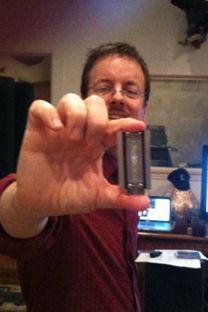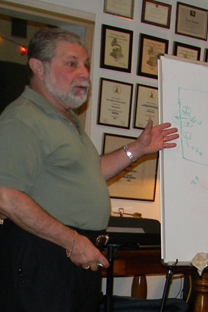JOHN JENNINGS - ROYER LABS
 John
Jennings has a mission: "I want to put ribbon microphones in
the hands of everyone who records music."
John
Jennings has a mission: "I want to put ribbon microphones in
the hands of everyone who records music."
John got
his start, like so many audio professionals, as a
guitar-player and singer on the east coast. Tempted westward
by friends and opportunities, John moved to Hollywood in
1990, playing the Los Angeles club circuit and spending time
in studios tracking with various bands.
In 1992 John
took a detour into the corporate world, becoming VP Sales &
Marketing for a Los Angeles based data and communications
firm and playing music in the evenings. During a recording
session in 1996, he came across a modified U-87 that sounded
"unbelievably good." After an introduction to the man who
modified the mic, David Royer, John left the suits & ties
behind and teamed with David and another friend to start a
new pro audio company - DVA. DVA ultimately closed due to
production problems, but David had talked a lot about ribbon
microphones during its brief existence. Between that
influential commentary and an interview with Eddie Kramer in
which Eddie said he always had a ribbon mic in the mix on
Jimi Hendrix's guitar cabinets, John's life was changed.
John and Dave met Rick Perrotta and Rafael Villafane in
late 1996. Digital recording was replacing the tape machines
of the day, and the guys realized that there was a real need
for the warmth and analog-like musicality of ribbon mics in
the upcoming, more clinical world of digital recording.
After much discussion and numerous business plans, Royer
Labs went into production in 1998 and John got busy handling
the sales and marketing. The Royer R-121 was unveiled at the
1998 AES show, ultimately leading to the re-emergence of
ribbon microphones around the world.
John Jennings
serves as VP Sales and Marketing for Royer Labs. He says
that his lifetime work is as "David Royer's pied piper,"
bringing David's ribbon microphone designs to studios and
engineers around the world.
Visit Site →
ART NOXON - ACOUSTIC SCIENCES CORPORATION
 Art
Noxon teaches the acoustic sessions in Bruce Swedien’s
workshop for recording engineers: In the studio with Bruce
Swedien. Art began teaching advanced recording studio
acoustics in Bruce’s first Critical Listening workshop,
January 2009 and has continued to teach every class since.
Art
Noxon teaches the acoustic sessions in Bruce Swedien’s
workshop for recording engineers: In the studio with Bruce
Swedien. Art began teaching advanced recording studio
acoustics in Bruce’s first Critical Listening workshop,
January 2009 and has continued to teach every class since.
Bruce opens up his personal studio every few months to mentor a group of recording engineers who have come from all over the world to learn his recording spice secrets. For the first 3 days of each 7 day workshop, Art teaches Bruce’s version of studio acoustics to the engineers. Because the typical student is well schooled and a seasoned recording engineer, the class runs at a very fast pace and finishes at the cutting edge of recording studio acoustics, which is exactly where Bruce works. The class builds on what is contained in the current edition of The New Audio Cyclopedia. A binder filled with supplemental information; along with class notes is provided.
Topics covered during the 15 hour short course include: Studio layout and construction, Haas effect, acoustic/sound waves, microphone design and use, room mode interaction with microphone and speaker placement, structural bass range soundproofing and sound conditioning, bass traps, acoustic MTF testing of playback rooms, attack transient control, the AttackWall control room design and midfield mic acoustic techniques using QSF and StudioTraps in the recording room. The design and construction of Bruce’s studio is carefully gone over, including the all the tricks used to get the high levels of performance he demands of the acoustic space he works in.
Bruce Swedien has been using TubeTraps in his recording studio work starting with Michael Jackson’s BAD album in 1987 and continues to do so today. Eventually he met the inventor of TubeTraps Art Noxon, and they began to work together on the acoustic parts of Bruce’s projects. Art has acoustically engineered the design and construction of Bruce’s last 4 home recording studios, including his present studio in Ocala, Florida. Visit Site →


